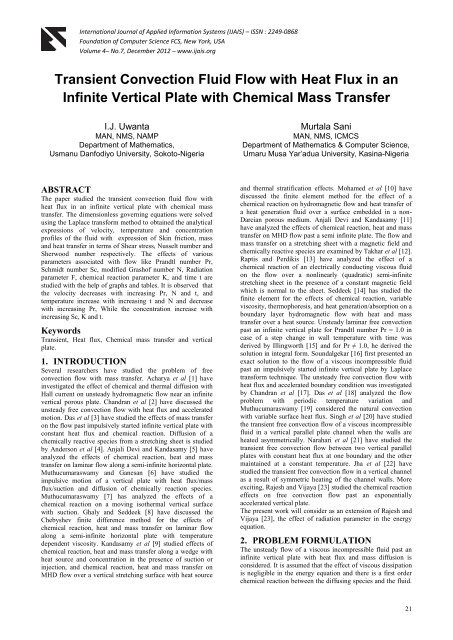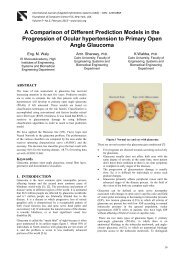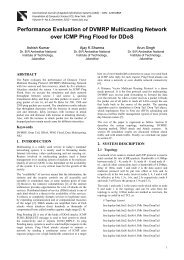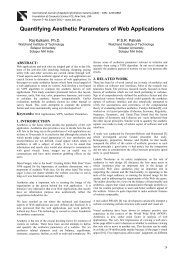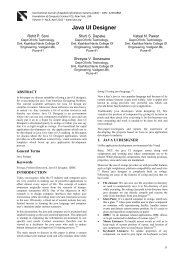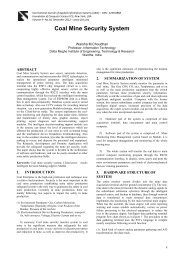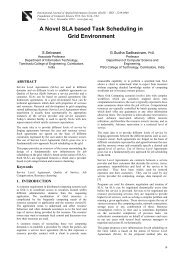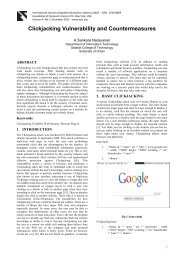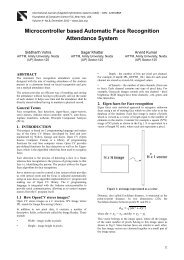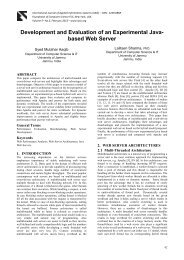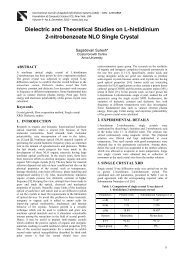y - International Journal of Applied Information Systems
y - International Journal of Applied Information Systems
y - International Journal of Applied Information Systems
Create successful ePaper yourself
Turn your PDF publications into a flip-book with our unique Google optimized e-Paper software.
<strong>International</strong> <strong>Journal</strong> <strong>of</strong> <strong>Applied</strong> <strong>Information</strong> <strong>Systems</strong> (IJAIS) – ISSN : 2249-0868<br />
Foundation <strong>of</strong> Computer Science FCS, New York, USA<br />
Volume 4– No.7, December 2012 – www.ijais.org<br />
Transient Convection Fluid Flow with Heat Flux in an<br />
Infinite Vertical Plate with Chemical Mass Transfer<br />
I.J. Uwanta<br />
MAN, NMS, NAMP<br />
Department <strong>of</strong> Mathematics,<br />
Usmanu Danfodiyo University, Sokoto-Nigeria<br />
ABSTRACT<br />
The paper studied the transient convection fluid flow with<br />
heat flux in an infinite vertical plate with chemical mass<br />
transfer. The dimensionless governing equations were solved<br />
using the Laplace transform method to obtained the analytical<br />
expressions <strong>of</strong> velocity, temperature and concentration<br />
pr<strong>of</strong>iles <strong>of</strong> the fluid with expression <strong>of</strong> Skin friction, mass<br />
and heat transfer in terms <strong>of</strong> Shear stress, Nusselt number and<br />
Sherwood number respectively. The effects <strong>of</strong> various<br />
parameters associated with flow like Prandtl number Pr,<br />
Schmidt number Sc, modified Grash<strong>of</strong> number N, Radiation<br />
parameter F, chemical reaction parameter K, and time t are<br />
studied with the help <strong>of</strong> graphs and tables. It is observed that<br />
the velocity decreases with increasing Pr, N and t, and<br />
temperature increase with increasing t and N and decrease<br />
with increasing Pr, While the concentration increase with<br />
increasing Sc, K and t.<br />
Keywords<br />
Transient, Heat flux, Chemical mass transfer and vertical<br />
plate.<br />
1. INTRODUCTION<br />
Several researchers have studied the problem <strong>of</strong> free<br />
convection flow with mass transfer. Acharya et al [1] have<br />
investigated the effect <strong>of</strong> chemical and thermal diffusion with<br />
Hall current on unsteady hydromagnetic flow near an infinite<br />
vertical porous plate. Chandran et al [2] have discussed the<br />
unsteady free convection flow with heat flux and accelerated<br />
motion. Das et al [3] have studied the effects <strong>of</strong> mass transfer<br />
on the flow past impulsively started infinite vertical plate with<br />
constant heat flux and chemical reaction. Diffusion <strong>of</strong> a<br />
chemically reactive species from a stretching sheet is studied<br />
by Anderson et al [4]. Anjali Devi and Kandasamy [5] have<br />
analyzed the effects <strong>of</strong> chemical reaction, heat and mass<br />
transfer on laminar flow along a semi-infinite horizontal plate.<br />
Muthucumaraswamy and Ganesan [6] have studied the<br />
impulsive motion <strong>of</strong> a vertical plate with heat flux/mass<br />
flux/suction and diffusion <strong>of</strong> chemically reaction species.<br />
Muthucumaraswamy [7] has analyzed the effects <strong>of</strong> a<br />
chemical reaction on a moving isothermal vertical surface<br />
with suction. Ghaly and Seddeek [8] have discussed the<br />
Chebyshev finite difference method for the effects <strong>of</strong><br />
chemical reaction, heat and mass transfer on laminar flow<br />
along a semi-infinite horizontal plate with temperature<br />
dependent viscosity. Kandasamy et al [9] studied effects <strong>of</strong><br />
chemical reaction, heat and mass transfer along a wedge with<br />
heat source and concentration in the presence <strong>of</strong> suction or<br />
injection, and chemical reaction, heat and mass transfer on<br />
MHD flow over a vertical stretching surface with heat source<br />
Murtala Sani<br />
MAN, NMS, ICMCS<br />
Department <strong>of</strong> Mathematics & Computer Science,<br />
Umaru Musa Yar’adua University, Kasina-Nigeria<br />
and thermal stratification effects. Mohamed et al [10] have<br />
discussed the finite element method for the effect <strong>of</strong> a<br />
chemical reaction on hydromagnetic flow and heat transfer <strong>of</strong><br />
a heat generation fluid over a surface embedded in a non-<br />
Darcian porous medium. Anjali Devi and Kandasamy [11]<br />
have analyzed the effects <strong>of</strong> chemical reaction, heat and mass<br />
transfer on MHD flow past a semi infinite plate. The flow and<br />
mass transfer on a stretching sheet with a magnetic field and<br />
chemically reactive species are examined by Takhar et al [12].<br />
Raptis and Perdikis [13] have analyzed the effect <strong>of</strong> a<br />
chemical reaction <strong>of</strong> an electrically conducting viscous fluid<br />
on the flow over a nonlinearly (quadratic) semi-infinite<br />
stretching sheet in the presence <strong>of</strong> a constant magnetic field<br />
which is normal to the sheet. Seddeek [14] has studied the<br />
finite element for the effects <strong>of</strong> chemical reaction, variable<br />
viscosity, thermophoresis, and heat generation/absorption on a<br />
boundary layer hydromagnetic flow with heat and mass<br />
transfer over a heat source. Unsteady laminar free convection<br />
past an infinite vertical plate for Prandtl number Pr = 1.0 in<br />
case <strong>of</strong> a step change in wall temperature with time was<br />
derived by Illingworth [15] and for Pr ≠ 1.0, he derived the<br />
solution in integral form. Soundalgekar [16] first presented an<br />
exact solution to the flow <strong>of</strong> a viscous incompressible fluid<br />
past an impulsively started infinite vertical plate by Laplace<br />
transform technique. The unsteady free convection flow with<br />
heat flux and accelerated boundary condition was investigated<br />
by Chandran et al [17]. Das et al [18] analyzed the flow<br />
problem with periodic temperature variation and<br />
Muthucumaraswamy [19] considered the natural convection<br />
with variable surface heat flux. Singh et al [20] have studied<br />
the transient free convection flow <strong>of</strong> a viscous incompressible<br />
fluid in a vertical parallel plate channel when the walls are<br />
heated asymmetrically. Narahari et al [21] have studied the<br />
transient free convection flow between two vertical parallel<br />
plates with constant heat flux at one boundary and the other<br />
maintained at a constant temperature. Jha et al [22] have<br />
studied the transient free convection flow in a vertical channel<br />
as a result <strong>of</strong> symmetric heating <strong>of</strong> the channel walls. More<br />
exciting, Rajesh and Vijaya [23] studied the chemical reaction<br />
effects on free convection flow past an exponentially<br />
accelerated vertical plate.<br />
The present work will consider as an extension <strong>of</strong> Rajesh and<br />
Vijaya [23], the effect <strong>of</strong> radiation parameter in the energy<br />
equation.<br />
2. PROBLEM FORMULATION<br />
The unsteady flow <strong>of</strong> a viscous incompressible fluid past an<br />
infinite vertical plate with heat flux and mass diffusion is<br />
considered. It is assumed that the effect <strong>of</strong> viscous dissipation<br />
is negligible in the energy equation and there is a first order<br />
chemical reaction between the diffusing species and the fluid.<br />
21
<strong>International</strong> <strong>Journal</strong> <strong>of</strong> <strong>Applied</strong> <strong>Information</strong> <strong>Systems</strong> (IJAIS) – ISSN : 2249-0868<br />
Foundation <strong>of</strong> Computer Science FCS, New York, USA<br />
Volume 4– No.7, December 2012 – www.ijais.org<br />
*<br />
The x -axis is taken along the plate in the vertically upward<br />
*<br />
direction and the y -axis is taken normal to the plate.<br />
Initially the plate and the fluid are at the same temperature<br />
*<br />
*<br />
T in the stationary condition with concentration level<br />
at all points. At time,<br />
accelerated with a velocity<br />
C <br />
*<br />
t 0 , the plate is exponentially<br />
**<br />
* at<br />
o<br />
u U e<br />
in its own plane<br />
and the temperature <strong>of</strong> the plate is raised at a uniform rate and<br />
the level <strong>of</strong> concentration near the plate is raised linearly with<br />
time. All the physical properties <strong>of</strong> the fluid are considered to<br />
be constant. The unsteady flow is governed by the following<br />
equations:<br />
* 2 *<br />
u u<br />
g T T g C C<br />
* *2<br />
t y<br />
* 2 *<br />
C C<br />
D K C C<br />
* *2<br />
t y<br />
Tk T Q<br />
t y <br />
* * * * *<br />
<br />
* * *<br />
*<br />
* T T<br />
* 2 *<br />
* <br />
C *2<br />
0<br />
C<br />
<br />
The initial and boundary conditions relevant to the fluid flow<br />
are:<br />
* * * * * *<br />
t* 0 : u 0, T T , C C For all y <br />
<br />
*<br />
<br />
**<br />
* at T<br />
q * * * <br />
t* 0 : u U e , , C C at y 0<br />
o *<br />
w <br />
y<br />
k<br />
<br />
* * * * * *<br />
u 0, T T , C C as y <br />
<br />
(4)<br />
*<br />
*<br />
*<br />
Where u is the axial velocity, t is time, T the fluid<br />
*<br />
temperature, is coefficient <strong>of</strong> volume, C is the fluid<br />
concentration,<br />
(1)<br />
(2)<br />
(3)<br />
*<br />
C w is wall concentration, D the mass<br />
*<br />
is the<br />
diffusivity, K is chemical reaction parameter,<br />
coefficient <strong>of</strong> concentration expansion.<br />
3. ANALYTICAL SOLUTION<br />
To solve the governing equations in dimensionless form, the<br />
following non-dimensional quantities were introduced:<br />
* * * 2<br />
y U0 u t U0 Q<br />
0<br />
y , U , t ,, F 2 <br />
U0 cU<br />
0 <br />
* * * * *<br />
T T C C a <br />
, c , a,<br />
<br />
* * 2<br />
q k Cw CU0 <br />
*<br />
(5)<br />
K c<br />
K , Sc ,Pr , <br />
2<br />
U0 D k<br />
<br />
<br />
2<br />
* * *<br />
gq g CwC Gr , Gc 4 3 <br />
kU 0 U0<br />
<br />
The governing equations on using (5) into (1) to (4) reduce to<br />
the following<br />
2<br />
u u<br />
Nc<br />
2<br />
t y<br />
<br />
tScy 2<br />
c 1 c<br />
Kc<br />
2<br />
2<br />
1 <br />
F<br />
2<br />
t Pr y<br />
Subject to the boundary conditions<br />
For t 0: u c 0,<br />
<br />
<br />
t <br />
for 0 y 1<br />
at ue , 1,<br />
y<br />
u 0, 0, c 0<br />
For 0:<br />
c 1 at y 0<br />
, as y <br />
To obtain the solutions, we apply the Laplace transform to (6)<br />
– (8) and the boundary conditions to get<br />
2<br />
d <br />
Pr 2 PF 0<br />
(9)<br />
dy<br />
2<br />
dC<br />
Sc 2 P K C<br />
dy<br />
(6)<br />
(7)<br />
(8)<br />
0<br />
(10)<br />
2<br />
dU<br />
PU NC<br />
2<br />
dy<br />
(11)<br />
The boundary conditions are<br />
t 0 : U C 0, y 1<br />
<br />
<br />
1 d<br />
1 1 <br />
t 0 : U , , C , at y 0<br />
P a dy P P <br />
U 0, 0, C 0, as y <br />
<br />
The solutions to (9) to (11) subject to (12) give<br />
(<br />
y, p)<br />
<br />
e<br />
C( y, p)<br />
<br />
Pr<br />
e<br />
k1<br />
y Z<br />
Z F<br />
k2Z<br />
Z K<br />
Z<br />
(12)<br />
(13)<br />
(14)<br />
22
U ( y, p)<br />
<br />
<strong>International</strong> <strong>Journal</strong> <strong>of</strong> <strong>Applied</strong> <strong>Information</strong> <strong>Systems</strong> (IJAIS) – ISSN : 2249-0868<br />
Foundation <strong>of</strong> Computer Science FCS, New York, USA<br />
Volume 4– No.7, December 2012 – www.ijais.org<br />
1<br />
<br />
<br />
<br />
y P<br />
Pr1 Pr b b F P b<br />
y P y P y Pr PF e e e<br />
<br />
b F P F b F P F b b F P b<br />
e<br />
<br />
y Pr PF y Pr PF e e N<br />
<br />
b F P F b FPFSc1c1 y P y P y Sc PK y Sc PK <br />
e e<br />
<br />
Pc1 P<br />
e<br />
<br />
p c1<br />
e<br />
<br />
P<br />
<br />
<br />
y P<br />
e <br />
<br />
P a (15)<br />
The Laplace inversions <strong>of</strong> (13), (14) and (15) yield the<br />
following<br />
<br />
Ft<br />
1 e k <br />
y t eerfc Ft <br />
Pr 2 F 2t <br />
k1F<br />
1<br />
, <br />
2<br />
y Pr<br />
<br />
4t<br />
k1F k1 e <br />
e erfc Ft <br />
<br />
2t F t<br />
<br />
(16)<br />
Kt<br />
e k2K<br />
k2<br />
c y, t e erfc Kt<br />
2<br />
<br />
2t And,<br />
u( y, t)<br />
<br />
k2K k2<br />
<br />
eerfc Kt <br />
2t (17)<br />
bt<br />
1 e<br />
<br />
Pr1Pr2bbF <br />
<br />
y b<br />
e erfc<br />
y<br />
<br />
2 t<br />
y b y<br />
bt e erfc <br />
2 t<br />
<br />
bt <br />
<br />
1 y <br />
1 y erfc <br />
e<br />
b F 2t F b F<br />
F Ft<br />
dt<br />
e k1d<br />
k1<br />
e erfc dt <br />
2bbF2 t <br />
Ft<br />
k1 d k1e k1<br />
F<br />
e erfc dt e<br />
erfc<br />
2 t 2bF<br />
k1 k1F k1<br />
<br />
Ft e erfc Ft <br />
2 t 2 t <br />
<br />
<br />
Ft<br />
ct 1<br />
e N e<br />
<br />
1 2<br />
y c1<br />
e erfc<br />
F b FSc c1<br />
<br />
y y c y <br />
1<br />
c1teerfc c1t 2 t 2 t <br />
ft<br />
y e k2f<br />
k2<br />
<br />
erfc e<br />
erfc ft<br />
2 t 2<br />
<br />
2 t <br />
Kt<br />
k2f k2e k2K<br />
e erfc ft e<br />
2t2 k k <br />
2 t 2 t <br />
2 k2K 2<br />
erfc Kt e erfc Kt<br />
at<br />
e y a y y a<br />
e erfc at e erfc<br />
2<br />
<br />
2t y <br />
at <br />
2t Where:<br />
KSc Pr F<br />
k1 y Pr; k2 y Sc; c1 ; d <br />
1Sc 1 Pr<br />
The Skin friction from the velocity is given by<br />
u<br />
y<br />
<br />
y 0<br />
<br />
<br />
<br />
(18)<br />
bt<br />
1 e 1 <br />
erfc<br />
<br />
Pr1Pr b<br />
b F2t <br />
1 1 <br />
berfc bt erfc <br />
b F 2t dt<br />
F e Pr <br />
erfc <br />
F b F b b F 2 t <br />
<br />
Pr derfc dt<br />
Ft<br />
e Pr <br />
erfc b F <br />
2 t <br />
<br />
Pr Ferfc Ft <br />
<br />
<br />
N ct 1 e <br />
Sc 1<br />
c<br />
<br />
<br />
<br />
1 1 <br />
erfc c1erfc c1terfc <br />
2 t <br />
2 t <br />
1<br />
23
<strong>International</strong> <strong>Journal</strong> <strong>of</strong> <strong>Applied</strong> <strong>Information</strong> <strong>Systems</strong> (IJAIS) – ISSN : 2249-0868<br />
Foundation <strong>of</strong> Computer Science FCS, New York, USA<br />
Volume 4– No.7, December 2012 – www.ijais.org<br />
<br />
ft Sc <br />
<br />
Kt<br />
e erfc Scf<br />
erfc ft e<br />
2 t <br />
<br />
<br />
Sc <br />
erfc <br />
2 t <br />
<br />
<br />
Sc Kerfc <br />
Kt <br />
<br />
at 1 <br />
eerfc <br />
2t aerfc <br />
at <br />
(19)<br />
Similarly, the Nusselt number become<br />
<br />
y<br />
y0<br />
Ft<br />
e Pr <br />
erfc Pr F <br />
2 t <br />
<br />
<br />
Pr<br />
<br />
Ferfc Ft<br />
While the Sherwood number is<br />
c<br />
y<br />
<br />
y 0<br />
(20)<br />
<br />
Kt Sc <br />
<br />
eerfc <br />
Sc Kerfc Kt <br />
2 t <br />
<br />
<br />
(21)<br />
4. RESULTS AND DISCUSSIONS<br />
From the analytical solutions, the numerical solutions for<br />
different values <strong>of</strong> the Prandtl number Pr, Schmidt number Sc,<br />
radiation parameter F, modified Grash<strong>of</strong> number N and<br />
chemical reaction parameter K were obtained. The following<br />
parameters values are fixed throughout the computation, Pr =<br />
0.71, N = 0.1, a = 0.2, t = 0.1, y = 0:0.02:40, Sc = 0.2, K =<br />
0.5, F = 0.5.<br />
Figures 1 to 9 are for the analytical solutions.<br />
The temperature pr<strong>of</strong>iles are illustrated in Figures 1 to 3 for<br />
different values <strong>of</strong> Prandtl number (Pr = 0.60, 0.71, 0.85,1),<br />
time (t = 1, 2, 3, 4) and radiation parameter (F = 1, 1.1, 1.2,<br />
1.3) shown in Figures 1, 2 and 3 respectively. In Figure 1, it’s<br />
observed that, the temperature decreases with increase in the<br />
Prandtl number. Figure 2 reveals that, the temperature<br />
increase with respect to increase in time. Similarly, Figure 3<br />
shows that the temperature increase with increase <strong>of</strong> the<br />
radiation parameter.<br />
The concentration pr<strong>of</strong>iles are presented in Figures 4 to 6 for<br />
different values <strong>of</strong> Schmidt number (Sc = 0.2, 0.4, 0.6, 0.8),<br />
time (t = 1, 2, 3, 4) and the chemical reaction parameter (K =<br />
1, 1.1, 1.2, 1.3). In Figure 4, it’s noticed that the concentration<br />
increase with increase in the Schmidt number. Figure 5<br />
indicates that increase in time increase the concentration.<br />
Similarly, Figure 6 shows that the concentration increase as<br />
the chemical reaction parameter increase.<br />
The velocity pr<strong>of</strong>iles have been studied and presented in<br />
Figures 7 to 9 with different values <strong>of</strong> radiation parameter (F<br />
= 0.02, 0.04, 0.06, 0.08), Prandtl number (Pr = 0.025, 0.60,<br />
0.71, 0.85) and (a = 0.1, 0.2, 0.3, 0.4). Figure 7 reveals that<br />
the velocity decreases with increase in the radiation<br />
parameter. Similarly, Figure 8 shows that the velocity<br />
decrease with increase in the Prandtl number. While in Figure<br />
9, it’s noticed that, there is a slight increase in velocity with<br />
increase in the value <strong>of</strong> a.<br />
Tables 1 to 5 are the tables for Skin friction, Nusselt number<br />
and Sherwood number for the analytical solution.<br />
The Skin frictions are illustrated in Tables 1 to 3 for different<br />
values <strong>of</strong> modified Grash<strong>of</strong> number (N = 0.1, 0.11, 0.21) and<br />
frequency <strong>of</strong> oscillation (a = 0.1, 0.2, 0,3), Prandtl number (Pr<br />
= 0.60, 0.71, 0.85) and radiation parameter (F = 0.02, 0.04,<br />
0.06), and Schmidt number (Sc = 0.2, 0.4, 0.6) and chemical<br />
reaction parameter (K = 1.0, 1.1, 1.2) shown in Tables 1, 2<br />
and 3 respectively. In Table 1, it’s observed that the Skin<br />
friction is decreasing with increasing modified Grash<strong>of</strong><br />
number while increase in the frequency <strong>of</strong> oscillation leads to<br />
increase in the Skin friction. Table 2 shows that as the Prandtl<br />
number increase, the Skin friction also increase but the Skin<br />
friction decrease with increase in the radiation parameter.<br />
Furthermore, Table 3 indicates that the Skin friction decrease<br />
whenever the Schmidt number increase and increase in the<br />
chemical reaction parameter results to decrease in the Skin<br />
friction.<br />
Table 4 shows that increasing Prandtl number leads to<br />
decrease <strong>of</strong> Nusselt number. Similarly, increase <strong>of</strong> the<br />
radiation parameter results to decrease <strong>of</strong> the Nusselt number.<br />
While Table 5 indicates that increase in Schmidt number and<br />
chemical reactions parameter increase the Sherwood number.<br />
Figure 1: Variation <strong>of</strong> Temperature against y for different<br />
values <strong>of</strong> Pr.<br />
Figure 2: Variation <strong>of</strong> Temperature against y for different<br />
values <strong>of</strong> t.<br />
24
<strong>International</strong> <strong>Journal</strong> <strong>of</strong> <strong>Applied</strong> <strong>Information</strong> <strong>Systems</strong> (IJAIS) – ISSN : 2249-0868<br />
Foundation <strong>of</strong> Computer Science FCS, New York, USA<br />
Volume 4– No.7, December 2012 – www.ijais.org<br />
Figure 3: Variation <strong>of</strong> Temperature against y for different<br />
values <strong>of</strong> F.<br />
Figure 4: Variation <strong>of</strong> Concentration against y for<br />
different values <strong>of</strong> Sc.<br />
Figure 5: Variation <strong>of</strong> Concentration against y for<br />
different values <strong>of</strong> t.<br />
Figure 6: Variation <strong>of</strong> Concentration against y for<br />
different values <strong>of</strong> K.<br />
Figure 7: Variation <strong>of</strong> Velocity against y for different<br />
values <strong>of</strong> F.<br />
Figure 8: Variation <strong>of</strong> Velocity against y for different<br />
values <strong>of</strong> Pr.<br />
Figure 9: Variation <strong>of</strong> Concentration against y for<br />
different values <strong>of</strong> a.<br />
Table 1: Skin Friction for different values <strong>of</strong> N and a.<br />
N 0.1 0.11 0.21<br />
A<br />
SF<br />
0.1 0.7379 0.7374 0.7329<br />
0.11 0.8466 0.8462 0.8417<br />
0.21 0.9264 0.9259 0.9214<br />
25
<strong>International</strong> <strong>Journal</strong> <strong>of</strong> <strong>Applied</strong> <strong>Information</strong> <strong>Systems</strong> (IJAIS) – ISSN : 2249-0868<br />
Foundation <strong>of</strong> Computer Science FCS, New York, USA<br />
Volume 4– No.7, December 2012 – www.ijais.org<br />
Table 2: Skin Friction for different values <strong>of</strong> Pr and F.<br />
Pr 0.60 0.71 0.85<br />
F<br />
SF<br />
0.02 2.4854 3.0350 4.5147<br />
0.04 2.2583 2.6740 3.6011<br />
0.06 2.1107 2.4314 2.9857<br />
Table 3: Skin Friction for different values <strong>of</strong> Sc and K.<br />
Sc 0.2 0.4 0.6<br />
K<br />
SF<br />
1.0 2.5477 2.4896 2.3171<br />
1.1 2.5342 2.4813 2.2857<br />
1.2 2.5323 2.4729 2.2536<br />
Table 4: Nusselt number for different values <strong>of</strong> Pr and F.<br />
Pr 0.60 0.71 0.85<br />
F<br />
Nu<br />
0.02 8.8407 8.1034 7.3813<br />
0.04 6.5221 5.9998 5.4881<br />
0.06 5.4913 5.0640 4.6454<br />
Table 6: Sherwood number for different values <strong>of</strong> Sc and<br />
K.<br />
Sc 0.2 0.4 0.6<br />
K<br />
Sh<br />
1.0 1.0564 1.4385 1.5137<br />
1.1 1.3619 1.4639 1.5423<br />
1.2 1.3825 1.4883 1.5696<br />
5. CONCLUSIONS<br />
The paper studied the transient convection fluid flow with<br />
heat flux in an infinite vertical plate with chemical mass<br />
transfer. The dimensionless governing equations were solved<br />
using the Laplace transform method. The effect <strong>of</strong> different<br />
parameters such as the Prandtl number, Schmidt number,<br />
radiation parameter and chemical reaction parameter were<br />
studied. The conclusion shows that:<br />
The concentration increase with increase in the<br />
Schmidt number, chemical reaction parameter<br />
and time.<br />
The velocity decrease with increasing Prandtl<br />
number, radiation parameter and frequency <strong>of</strong><br />
oscillation.<br />
The temperature increase with increase in time<br />
and the radiation parameter while the<br />
temperature decrease with increasing Prandtl<br />
number.<br />
6. REFERENCES<br />
[1] Acharya, M., Dash, G. C. and Singh, L. P. 1995. Effect<br />
<strong>of</strong> chemical and thermal diffusion with Hall current on<br />
unsteady hydromagnetic flow near an infinite vertical<br />
porous plate. <strong>Journal</strong> <strong>of</strong> <strong>Applied</strong> Physics, 28, 2455-2464.<br />
[2] Chandran, P., Sacheti, N. C. and Singh, A. K. 1998.<br />
Unsteady free convection flow with heat flux and<br />
accelerated boundary motion. <strong>Journal</strong> <strong>of</strong> Physics Society<br />
<strong>of</strong> Japan, 67, 124-129.<br />
[3] Das, U. N., Deka, R. K. and Soundalgekar, V. M. 1994.<br />
Effects <strong>of</strong> mass transfer on flow past an impulsively<br />
started infinite vertical plate with constant heat flux and<br />
chemical reaction. Forschung im Ingenieurwesen,<br />
60(10), 284–287.<br />
[4] Andersson, H. I., Hansen, O. R. and Holmedal, B. 1994.<br />
Diffusion <strong>of</strong> a chemically reactive species from a<br />
stretching sheet. <strong>International</strong> <strong>Journal</strong> <strong>of</strong> Heat and Mass<br />
Transfer, 37(4), 659–664.<br />
[5] Anjali, S. P. and Kandasamy, R. 1999. Effects <strong>of</strong><br />
chemical reaction, heat and mass transfer on laminar<br />
flow along a semi infinite horizontal plate. Warme-und<br />
St<strong>of</strong>fubertragung Zeitschrift, 35(6), 465–467.<br />
26
<strong>International</strong> <strong>Journal</strong> <strong>of</strong> <strong>Applied</strong> <strong>Information</strong> <strong>Systems</strong> (IJAIS) – ISSN : 2249-0868<br />
Foundation <strong>of</strong> Computer Science FCS, New York, USA<br />
Volume 4– No.7, December 2012 – www.ijais.org<br />
[6] Muthucumaraswamy, R. and Ganesan, P. 2000. On<br />
impulsive motion <strong>of</strong> a vertical plate with heat flux and<br />
diffusion <strong>of</strong> chemically reactive species. Forschung im<br />
Ingenieurwesen, 66(1), 17–23.<br />
[7] Muthucumaraswamy, R. 2002. Effects <strong>of</strong> a chemical<br />
reaction on a moving isothermal vertical surface with<br />
suction. <strong>Journal</strong> Acta Mechanica, 155(1-2), 65–70.<br />
[8] Ghaly, A. Y. and Seddeek, M. A. 2004. Chebyshev finite<br />
difference method for the effects <strong>of</strong> chemical reaction,<br />
heat and mass transfer on laminar flow along a semi<br />
infinite horizontal plate with temperature dependent<br />
viscosity. <strong>Journal</strong> <strong>of</strong> Chaos, Solitons and Fractals, 19(1),<br />
61–70.<br />
[9] Kandasamy, R., Periasamy, K. and Prabhu, K. S. 2005.<br />
Effects <strong>of</strong> chemical reaction, heat and mass transfer<br />
along a wedge with heat source and concentration in the<br />
presence <strong>of</strong> suction or injection. <strong>International</strong> <strong>Journal</strong> <strong>of</strong><br />
Heat and Mass Transfer, 48(7), 1388–1394.<br />
[10] Mohamed, R. A., Abbas, I. A. and Abo-Dahab, S. M.<br />
2009. Finite element analysis <strong>of</strong> hydromagnetic flow and<br />
heat transfer <strong>of</strong> a heat generation fluid over a surface<br />
embedded in a non-Darcian porous medium in the<br />
presence <strong>of</strong> chemical reaction. Communications in<br />
Nonlinear Science and Numerical Simulation, 14(4),<br />
1385–1395.<br />
[11] Anjali, S. P. and Kandasamy, R. 2000. Effects <strong>of</strong><br />
chemical reaction, heat and mass transfer on MHD flow<br />
past a semi infinite plate. Zeitschrift fur Angewandte<br />
Mathematik undMechanik, 80(10), 697–701.<br />
[12] Takhar, H. S., Chamkha, A. J. and Nath, G. 2000. Flow<br />
and mass transfer on a stretching sheet with a magnetic<br />
field and chemically reactive species. <strong>International</strong><br />
<strong>Journal</strong> <strong>of</strong> Engineering Science, 38(12), 1303–1314.<br />
[13] Raptis, A. and Perdikis, C. 2006. Viscous flow over a<br />
non-linearly stretching sheet in the presence <strong>of</strong> a<br />
chemical reaction and magnetic field. <strong>International</strong><br />
<strong>Journal</strong> <strong>of</strong> Non-Linear Mechanics, 41(4), 527–529.<br />
[14] Seddeek, M. A. 2005. Finite element method for the<br />
effects <strong>of</strong> chemical reaction, variable viscosity,<br />
thermophores is and heat generation/absorption on a<br />
boundary layer hydromagnetic flow with heat and mass<br />
transfer over a heat surface. <strong>Journal</strong> Acta Mechanica,<br />
177(1–4), 1–18.<br />
[15] Illingworth, C. R. 1950. Unsteady laminar flow <strong>of</strong> gas<br />
near an infinite plate, Cambridge Philosopical Society,<br />
44, 603-613.<br />
[16] Soundalgekar, V. M. 1977. Free convection effects on<br />
Stokes problem for a vertical plate. <strong>Journal</strong> <strong>of</strong> Heat<br />
Transfer, 99c, 499–501.<br />
[17] Chandran, P., Sacheti, N. C. and Singh, A. K. 1998.<br />
Unsteady free convection flow with heat flux and<br />
accelerated boundary motion. <strong>Journal</strong> <strong>of</strong> Physics Society<br />
<strong>of</strong> Japan, 67, 124-129.<br />
[18] Das, U. N., Deka, R. K. and Soundalgekar, V. M. 1999.<br />
Transient free convection flow past an infinite vertical<br />
plate with periodic temperature variation. <strong>Journal</strong> <strong>of</strong> Heat<br />
Transfer, 121, 1091–1094.<br />
[19] Muthucumaraswamy, R. 2004. Natural convection on<br />
flow past an impulsively started vertical plate with<br />
variable surface heat flux. Far East <strong>Journal</strong> <strong>of</strong> <strong>Applied</strong><br />
Mathematics, 14, 99–109.<br />
[20] Singh, A. K., Gholami, H. R. and Soundalgekar, V. M.<br />
1996. Transient free convection flow between two<br />
vertical parallel plates. <strong>Journal</strong> <strong>of</strong> heat and Mass<br />
Transfer, 31, 329-331.<br />
[21] Narahari, M., Sreenadh, S. and Soundalgekar, V. M.<br />
2002. Transient free convection flow between long<br />
vertical parallel plates with constant heat flux at one<br />
boundary. <strong>Journal</strong> <strong>of</strong> Thermophysics and<br />
Aeromechanics, 9(2), 287-293.<br />
[22] Jha, B. K., Singh, A. K. and Takhar, H. S. 2003.<br />
Transient free convection flow in a vertical channel due<br />
to symmetric heating. <strong>International</strong> <strong>Journal</strong> <strong>of</strong> <strong>Applied</strong><br />
Mechanics and Engineering, 8(3), 497-502<br />
[23] Rajesh, V. and Vijaya, S. Kumar Varma 2010. Chemical<br />
reaction effects on free convection flow past an<br />
exponentially accelerated vertical plate. <strong>International</strong><br />
<strong>Journal</strong> <strong>of</strong> Engineering, 1, 1584-2665.<br />
27


